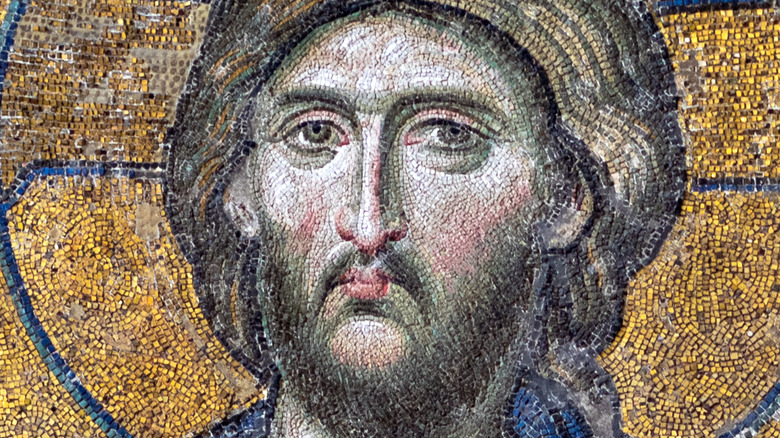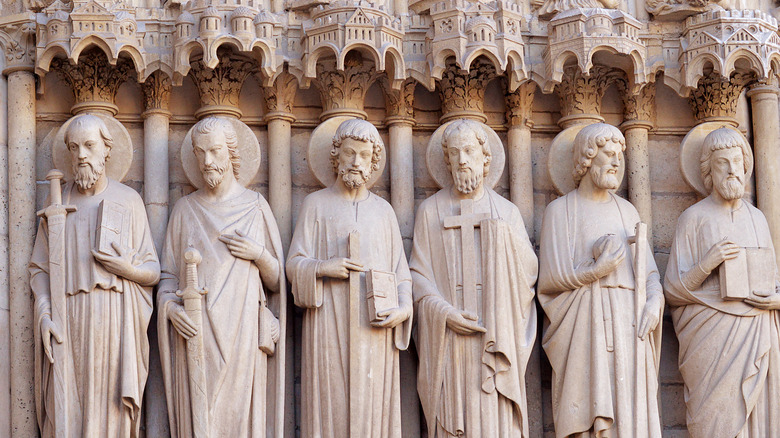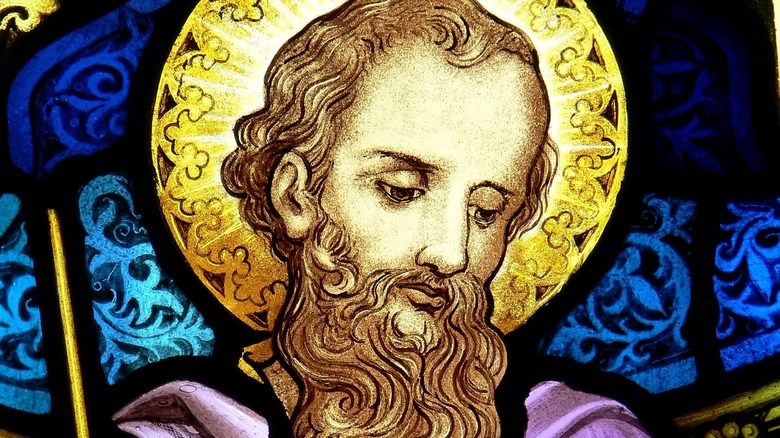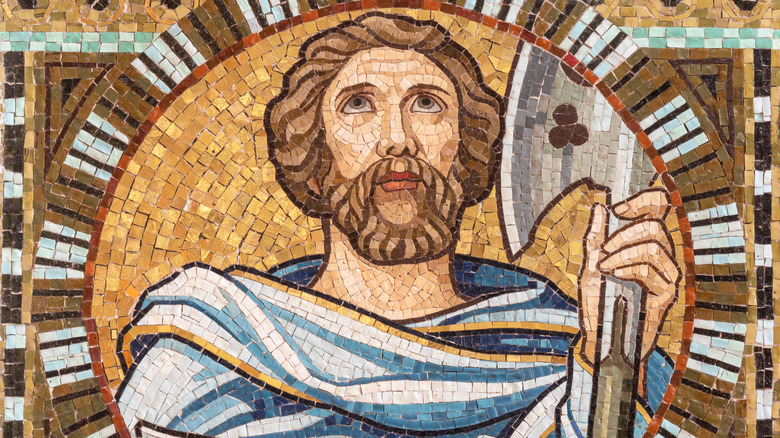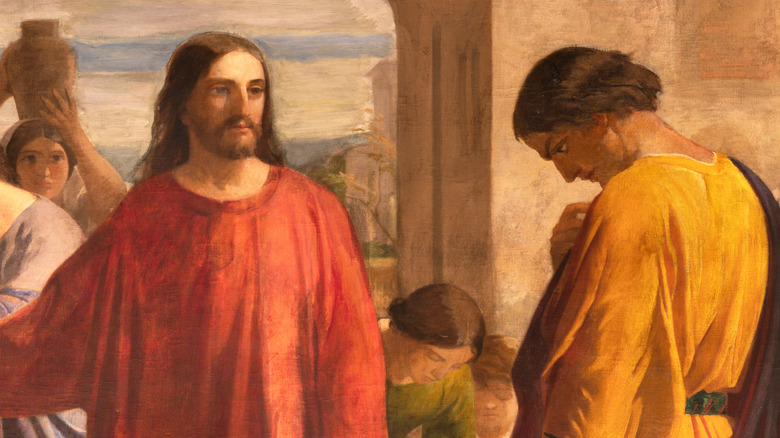The Untold Truth Of Jesus' Siblings
Jesus may have started the world's largest religion, but we know surprisingly little about him beyond what's recorded in the gospels. We don't know his favorite food, his favorite joke, how he wore his hair, or even whether he had brothers and sisters — sort of.
It turns out that if you just read the gospels at face value, they're actually pretty straightforward about the matter. Matthew 12:46 and 13:55, Mark 3:31 and 6:3, Luke 8:19 and John 2:12 and 7:3 all make direct references to either Jesus' brothers or Jesus' brothers and sisters. Some writers call his four brothers out by name: James, Joses, Simon, and Judas. So that's it, then, right? Case closed, four brothers and some number of sisters. Right?
Except since at least the fourth century, most Christians have held that Jesus' mother Mary remained perpetually a virgin, making the most obvious interpretation of these passages a fairly unpopular one. So, where does that leave us? Who were these mysterious "brothers and sisters" of Jesus? That depends on who you ask and how you define "brothers and sisters."
Three theories
While both the Gospel of Matthew and the Gospel of Luke assert that Mary was a virgin prior to the birth of Christ, the "perpetual virginity" doctrine — the idea that Mary remained a virgin even during and after the birth — doesn't show up anywhere until the second century, where it appears in the noncanonical "Protoevangelium of James." The idea proved popular enough that it was established as orthodoxy at the ecumenical Council of Ephesus in A.D. 431 (via University of Dayton), and has been reaffirmed by both the Catholic and Eastern Orthodox traditions several times since, which might present something of a problem to anyone reading the previously mentioned passages.
With that in mind, there are three main theories used to explain the passages: the "brothers and sisters" were actual (half-) brothers and (half-) sisters (that is, children of both Mary and Joseph); the "brothers and sisters" were step-siblings (i.e., Joseph's children from a previous marriage); or the Greek word for "brothers and sisters" — adelphoi — actually means "cousins" (via BibleInfo).
As you can imagine, most Protestants (who generally don't accept the perpetual virginity doctrine) are fine with interpretation #1, but Orthodox and Catholic Christians prefer either #2 or #3 (respectively, for the most part).
Some conjecture is involved
Both of the latter theories might seem like reaches, but there actually are solid arguments for the second one (via BibleInfo). Supporters point out that several of the passages that mention brothers have the brothers trying to boss Jesus around — unlikely, in the culture of the time, if they were younger than he.
Further, at the end of the Gospel of John, when Jesus is dying, he says to his mother, "Woman, behold, your son," referring to the Apostle John; the implication is that John should care for her in her old age, since Jesus won't be able to. If Mary had had other children, though, it would be a strange choice on Jesus' part to assign John to the job, instead of letting one of his brothers do it.
As for the cousins theory — that one's mostly conjecture. It's been defended, per U.S. Catholic, by none other than St. Jerome, the fourth-century priest who translated the Bible into Latin, and belief in the teaching dates back to at least the second century A.D. (per University of Dayton). Regardless of whether Jesus had siblings through Mary, Joseph, both, or neither, it's quite clear there were at least six people who were considered some kind of blood relative of Jesus in the early church.
St. James the Just
Of Jesus' six relatives, who may or may not have been siblings, there are two who have New Testament books attributed to them and four that we know almost nothing about. The first of the two prominent siblings is James, whom St. Paul calls "the Lord's brother" in Galatians 1:19. Later in the book, Paul calls James one of the "pillars of the church," and in 1 Corinthians, Paul lists James among the people Jesus appeared to after his resurrection. In his own book, James describes himself simply as "a servant of God and of the Lord Jesus Christ."
Outside of Scripture, we know a little bit about James: He served as the first bishop of the church in Jerusalem, and, according to tradition, was fairly popular with Jews in the area due to his scrupulous observance of Torah law (which is where he got his nickname "the Just," per Britannica).
Despite his commitments to Jewish practice, though, James is portrayed in Acts 15 as arguing against making Gentile Christians keep kosher law.
St. Jude / Judas
Jesus literally had a brother named Judas. Obviously, we're talking about a different guy from Judas Iscariot, the one who betrayed him with a kiss — turns out "Judas" was just a super-common name in first-century Judea (which literally means something like "land of Judas"). With that in mind, it's not surprising there are several Judases in the New Testament, one of which is listed among Jesus' 12 disciples. Given that "Judas" suddenly became an unpopular name right around the time Christianity was getting off the ground, most mentions of this Judas in the Bible either shorten his name to "Jude" or else just call him by what was apparently his nickname, "Thaddaeus" (via Encyclopedia.com).
Given the commonness of the name "Jude/Judas" in the New Testament, it's actually not particularly clear whether Jude the Apostle and Jude the brother of Jesus are the same person, but it is clear that they both served in the early church. Jude, the "servant of Jesus Christ," wrote the letter that would become the second-to-last book in the Bible, where he describes himself, modestly, as "the brother of James."
The Epistle of Jude is probably most notable, by the way, for quoting liberally from books generally recognized as non-canonical by nearly all modern Christians and Jews, like 1 Enoch and the Testament of Moses.
Questions remain
We know almost nothing of the remainder of Jesus' maybe-siblings, a group that includes at least two more brothers and two sisters. The other two brothers are named in several of the gospels as "Joses" (a variant of the name Joseph) and "Simon"; the sisters aren't named at all.
Realistically, we have no idea who these people are, but fourth-century bishop Epiphanius of Salamis says the sisters' names were Anna and Salome — although, per Charles A. Sullivan, Epiphanius gives the names as Mary and Salome elsewhere. Either way, Jesus allegedly had a sister named Salome, which was also the name of the woman who talked King Herod Antipas into murdering Jesus' cousin, John the Baptist (via Britannica).
Whether they were children of Mary and Joseph, children of Joseph and someone else, or children of aunts and uncles, it's clear there were at least a handful of people who were recognized as close blood relatives of Jesus — two of whom had prominent roles in early Christianity.
